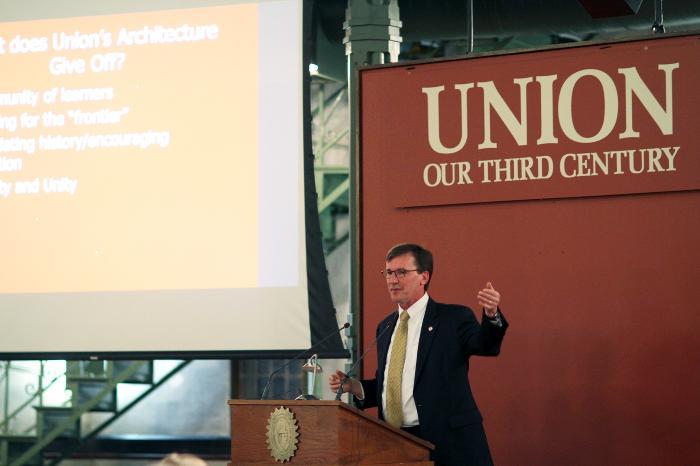The genius of Joseph Ramée echoed through the Nott Memorial
and other parts of campus this weekend as Union celebrated its distinction of being the first American college or university to be designed with a comprehensive plan.
"It's significant the way the Ramée plan has continued to live since its creation," Paul Turner '62, professor emeritus of architectural history at Stanford University, told close to 100 people who participated in this year's Alumni and Friends Symposium, "Surveying the Campus Landscape: A Bicentennial Celebration and Examination of Joseph Ramée's and Eliphalet Nott's Grand Plan."
Two hundred years ago, the French architect, working closely with Nott, designed a campus that became a model for collegiate planning. Among the many campus designs it likely influenced was Thomas Jefferson's for the University of Virginia and Frederick Law Olmsted's for Stanford University.
Over three days, a series of talks, panel presentations and tours dissected the design that continues to guide the College's growth today. The idea of the annual symposium is to help graduates re-engage in the intellectual life they enjoyed at Union.
In his opening address Friday night, Turner, author of Joseph Ramée: International Architect of the Revolutionary Era and Campus: An American Planning Tradition, introduced the audience to the unheralded architect and shared his expertise on the long-forgotten drawings that were discovered in a campus attic in 1932.
"Even though it was not fully executed as Ramée and Nott originally intended, the basic nature of the design has always been recognized, by the Union community, as essential to the college - as a physical symbol of the school's identity and character," Turner said. "All of this shows a remarkable respect for an architectural plan, and an acknowledgment that a well-planned and harmonious environment can contribute to the success of an institution."
President Stephen C. Ainlay delivered a provocative talk Saturday night on "The Built and Unbuilt Union," highlighting some of the campus architecture that departed from the Ramée plan, including Washburn Hall (built in 1883 and razed in 1963) and the Nott Memorial. While a key element of Ramée's plan called for a central rotunda, it wasn't until decades later that the Nott Memorial, designed by Edward Potter, took shape, and not in way envisioned by Ramée.
"But the fact that it's different from the Ramée plan is what gives the Nott its power," Ainlay said of the 16-sided building that was added to the National Register of Historic Places in 1972 and to the list of National Historic Landmarks in 1986.
Ainlay shared a number of plans that have emerged over the years that, for a host of reasons, were never built, including the Robert Porter Patterson Memorial Library in 1952, named after the Class of 1912 alum. There was also a plan at one time to resurface the Nott and to add columns.
In reviewing new campus projects, including the Henle Dance Pavilion (to be dedicated over ReUnion weekend), Ainlay assured the audience that the College will continue to adhere to the guiding principles of Ramée's plan in shaping future growth.
"This is sacred space," Ainlay said. "This is space that can't be touched or violated."
Other speakers included renowned campus architect Art Lidsky, president of Dober Lidsky Mathey, who discussed campus planning trends and challenges faced by colleges and universities, and Ellen Fladger, head of the College's Special Collections, who provided an overview of the Ramée drawings.
Panelists included Lynne Birdsall '76, director of admissions at Sterling College (Vermont); William Carey '86, engineer, Divney Tung Schwalbe; James Carl '84, associate professor, Cleveland State University; Cynthia Curtis-Budka '87, associate professor, The College of New Jersey; David Duchscherer '67, principal, Wendel Duchscherer; Jayme Lahut '83, executive director, Schenectady Metroplex; Steven Levy '72; Donald Lippman '82, president, DEL Development Corporation; Peter Martini '78, vice president and project executive, Commodore Builders; Robert Powers '77, historic preservationist, Powers and Company, Inc.; and Theron Russell '75, project manager, Forest City Ratner Companies.
A reporter who covers architecture for the Chronicle of Higher Education attended the symposium.
To read an op-ed by Turner that appeared in Sunday's Times Union, click here.
To read a front page story in the Times Union on the celebration of the Ramée plan, click here.
The first Alumni and Friends Symposium, held in 2007, was modeled after the “Moral Dilemmas of Governing” class led for many years by Byron Nichols. Twenty former students of Nichols, who taught political science from 1968 to 2008, returned to Union for a spirited discussion on the moral and political issues surrounding illegal immigration.
